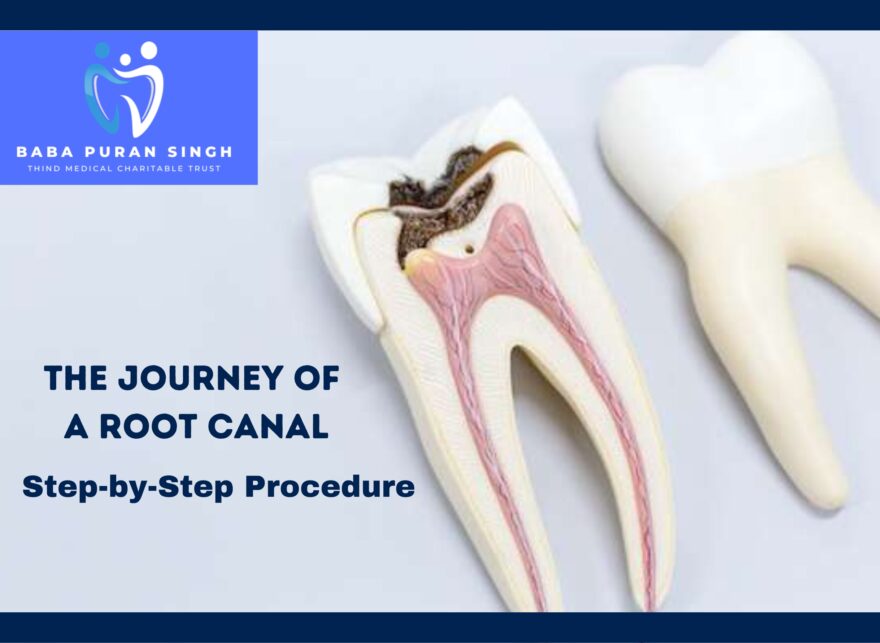Root canal treatment, often surrounded by myths and misconceptions, is a crucial dental procedure aimed at saving a severely damaged or infected tooth. At Baba Puran Singh Dental Charitable Trust in Ludhiana, we understand the importance of demystifying dental procedures for our community. In this comprehensive guide, we’ll take you through the step-by-step journey of a root canal, shedding light on what to expect during this essential dental intervention.
Read: Innovation in Dental Training: Equipping Dentists for Modern Challenges
1. Understanding the Need for a Root Canal
The journey begins with the identification of the need for a root canal. Common indications include:
- Severe Toothache: Persistent and intense tooth pain, often aggravated by chewing or temperature changes.
- Swollen Gums: Swelling and tenderness in the gums surrounding the affected tooth.
- Prolonged Sensitivity: Increased sensitivity to hot or cold that lingers even after the stimulus is removed.
- Darkening of the Tooth: Discoloration of the tooth, indicating damage to the pulp.
2. Diagnostic Phase
a. Clinical Examination:
Our experienced dentists conduct a thorough clinical examination, assessing the symptoms and the affected tooth. Advanced diagnostic tools may be employed, such as digital X-rays, to visualize the internal structures of the tooth.
b. Pulpal Evaluation:
If the pulp (the innermost part of the tooth containing nerves and blood vessels) is found to be infected or damaged, a root canal is recommended. This evaluation ensures that a root canal is the most appropriate course of action.
Read: Affordable Dental Care: Our Commitment to Your Smile
3. Treatment Planning
Once the need for a root canal is established, a personalized treatment plan is created. The dentist discusses the details of the procedure, answers any questions, and ensures the patient is informed and comfortable with the upcoming intervention.
4. Local Anesthesia: Ensuring Comfort
Before commencing the root canal, the dentist administers local anesthesia to numb the tooth and the surrounding area. This guarantees that the patient will be as comfortable as possible throughout the process.
5. Access Opening: Reaching the Pulp
To get to the pulp chamber, the dentist makes a tiny access hole in the tooth’s crown. This step is essential for effectively cleaning and disinfecting the pulp.
Read: Beyond Dentistry: Our Charitable Trust’s Holistic Approach to Oral Health
6. Cleaning and Shaping: Removing Infected Tissue
a. Removal of Pulp Tissue:
Specialized tools are used to carefully remove the infected or damaged pulp tissue from the pulp chamber and root canals. This step is crucial for preventing the spread of infection.
b. Cleaning the Canals:
The root canals are meticulously cleaned to eliminate bacteria, debris, and any remaining pulp tissue. This process ensures the thorough disinfection of the tooth’s interior.
c. Shaping the Canals:
The canals are shaped to facilitate the filling process. This step involves creating a space that allows for the proper sealing of the canals.
7. Filling and Sealing: Protecting the Tooth
a. Filling Material:
Gutta-percha, a biocompatible substance, is used to fill the canals after they have been cleaned and formed. By sealing the channels, this substance stops bacteria from entering.
b. Sealing the Access Opening:
The access opening created at the beginning of the procedure is sealed with a temporary or permanent filling to protect the interior of the tooth.
8. Restoration: Bringing Back Functionality
In many cases, a tooth that undergoes a root canal may require additional restoration for full functionality. This can involve placing a dental crown to strengthen and protect the treated tooth.
9. Post-Treatment Care and Recovery
After the root canal, patients are provided with post-treatment care instructions. It’s essential to follow these guidelines to ensure proper healing and recovery. This may include managing discomfort, avoiding certain foods, and taking prescribed medications.
Read: Spreading Oral Hygiene Awareness: Our Initiatives and Impact
Conclusion
The journey of a root canal at Baba Puran Singh Dental Charitable Trust reflects our commitment to providing accessible and compassionate dental care to the Ludhiana community. By understanding the step-by-step process, we aim to demystify root canal treatment and emphasize its role in saving natural teeth. If you’re experiencing dental issues or have been recommended a root canal, rest assured that our dedicated team is here to guide you through the process with expertise and care. Your journey to a healthier, pain-free smile begins with us at Baba Puran Singh Dental Charitable Trust in Ludhiana.

